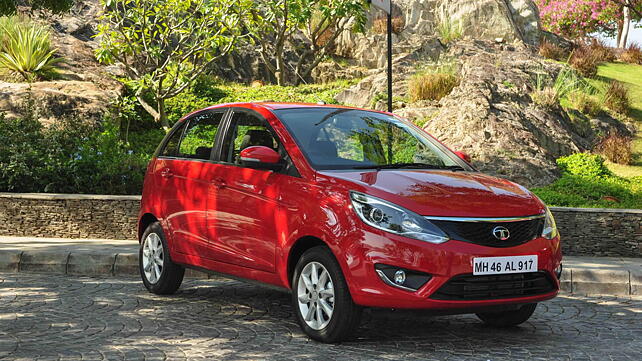Introduction

The Bolt is the second car from Tata Motors under HorizoNext, which will be launched not only to offer more value in the hatchback segment, but also to move away from the ‘taxi image’ created by its predecessor. The Zest is already doing great in the passenger car market and the hatchback is further expected to boost its image.
The one thing common to all Tata hatchbacks is that they offer great value and the Bolt was not expected to be any different. The first drive in Udaipur then was also to find out if it is different enough to move away from the baggage that comes with the Indica badge.
Looks
There are ample similarities between the Bolt and the Vista since they are based on the same platform. The dimensions and stance is pretty similar and in fact, from the front, the Bolt looks like a premium, more accessorised version of the Indica Vista hatchback.

The bonnet gets V-shaped creases at the centre and a pair of lines on the side that sort of form a border. It is however same as that of the Vista in silhouette. The front grille with chrome stripe on the top is also like that of the Vista, only a little more defined. The new headlamps on the other hand look very nice with the blacked-out interior and the segment first projector units. The chrome element at the bottom of the lamps look like LED DRLs, though these are just reflectors. The front bumper is big and sculpted with an equally big trapezoidal air dam. It also houses the fog lamp console that gets chrome inserts.

The side profile has the looks of a premium hatchback with a thick shoulder and waist line, turn indicators on the wing mirrors and 15-inch alloy wheels. Tata was the first Indian manufacturer to try the floating roof on the hatchback with blacked-out C-pillar at the 2014 Auto Expo. However, the Hyundai i20 beat it to the launch and hence this get up will remind you of Hyundai’s premium hatch. Also the bad thing here is that the black element is just a vinyl (sticker), unlike the black coloured body panel used by the Korean manufacturer.

The rear design is unlike any of the Tata cars. The bumper at the back is again extremely fat and is moulded in an interesting shape with pointed ends. The tail lamp console is compact and horizontal; a lot different from the Christmas tree-styled vertical design we are used to seeing on the Tata cars. It also gets a chrome stripe along with the Bolt, Revotron and XT (variant) badging.
The overall design of the Tata Bolt is nice and the car certainly looks premium. However, I was hoping that the new hatchback would completely move away from the Indica design and hence am not too happy that the front still is reminiscent of the Vista. I know I am sounding cheesy here but, probably it will be a little easier to get bolts out of the Indica, than to get Indica out of the Bolt.
Interior

Tata has tried to position the Bolt as a sporty hatchback and it gets an all-black interior following this theme. The fit and finish is largely improved compared to the rest of the Tata hatchbacks and the overall design is exactly like that of the Zest, only darker with Java black finish. The dark colour doesn’t change the perspective of the cabin though; it is still the biggest in the segment and can comfortably fit three on the rear bench.

The Bolt gets a lot of interesting features starting with the Harman music system with eight speakers that is way better than the competition. It is same from the Zest, but it now gets two more additional features – the infotainment system can play videos and more importantly work as an interface for navigation maps that are provided to the owner at the time of buying the car. The navigation is a very interesting and affordable solution, which will probably be replicated by many in the coming months.

This hatchback is not the most feature rich car, that tag still belongs to the Hyundai Grand i10. While it gets climate control, segment first projector headlamps, steering mounted audio control and voice command, features like keyless start and rear AC vents are missing. Also the interior design could have been better; there is only one bottle holder at the front and hardly any place to keep the mobile and wallet. The old platform has also affected the boot space, at 210 litres it is bigger than that of the Maruti Swift, but lot smaller in comparison to the Ford Figo and the Hyundai Grand i10.

The Bolt does not feel like any of the previous Tata cars, it feels premium and that is a big plus. However, I would have been happier if a little more thought would have gone into developing an ergonomic design.
Performance

We drove the petrol version of the Bolt in Udaipur, powered by their new 1.2-litre turbocharged Revotron engine. The car has the segment best power figures of 89bhp and 140Nm of torque, along with the innovative power modes that can be changed for performance and efficiency. The Bolt shares its drivetrain with the Zest compact sedan, however, the gearing is shorter for spirited driving. The five-speed gearbox is slick and with the short throws feels like made for enthusiastic driving.

The three power modes – City, Eco and Sport, alter the engine performance as required. By default, the car is always in City mode with a balance of power and efficiency, in Eco mode the performance is noticeably dull for efficiency and shows its full potential only in the Sport mode. It plays with the performance by changing the fuel supply to the engine via the ECU.
The car feels reluctant to get off the line in Eco and City mode; both Rohan and I stalled the car couple of times. Things are a lot better in Sport mode though and I would actually advise switching to this for bumper to bumper traffic. The turbo spools at around 1,800rpm and the power delivery is very linear.
The biggest advantage of this engine is the class leading torque figure and there is no need to down a gear for quick overtake. It has ample bottom end grunt for a petrol hatchback, which is good enough to get out of a sticky situation. We barely managed 100kph on our short drive, but getting there didn’t require much effort. The safety aspect has not been ignored and the Bolt gets two airbags, ABS-EBD and CSC (Corner Stability Control) at least with the top-end XT variant.
The on-board computer suggested we got 15kpl through our 80km test run, decent figures for a car with shorter gear ratios. The Bolt will also be available with the 1.3-litre multijet diesel engine delivering 75bhp and 190Nm of torque – it is the same engine and configuration that powers the Tata Vista, Suzuki Swift and a couple of other cars in the segment.
Tata is not offering the AMT transmission from the Zest with the diesel hatchback at this moment but we are hoping it will be part of the range soon, as the first diesel AT hatchback in the segment.
Ride & Handling

The ride quality at city speeds is surprisingly good. We went through a number of potholes in Udaipur city and the Bolt managed to flatten everything without even a squeak entering the cabin. It feels soft and Tata has used a new dual path suspension at the front that has also improved the handling without compromising the ride.

Unfortunately we didn’t get to properly test the handling in our short drive, though it seems that it is not as crisp as one would expect from a car that is intended to be positioned for the enthusiasts. The new electric power steering is wonderful at city speeds and also weighs up pretty well for the highways. Like in all the EPS (electronic power steering) on budget cars, the feel is lacking; however, this one provides decent feedback. The NVH levels are decent even at high speeds and the part of the credit goes to the GoodYear 175/65 R15 tyres.
Verdict

The Bolt ticks all the right boxes in terms on performance, space and features. It is in line with Tata’s biggest USP - cabin space, the hatchback in terms of cabin space is bigger than all the competitors. The performance of the new turbocharged petrol engine is also better than the rivals; it is a segment first and even takes the refinement to the next level. Tata may not have matched Hyundai on the features list by numbers, but things like Sat Nav interface and projector headlamps are actually more useful to have.
Most important thing that Tata has done is move away from the Indica badge. The new car will consciously be kept away from the fleet market, assuring the customers that the brand will never be tagged as a ‘taxi’. The only thing that still works against the Bolt, is the silhouette and front of the Indica. However, even that is heavily altered and should not be considered a big hurdle in giving it a chance.































